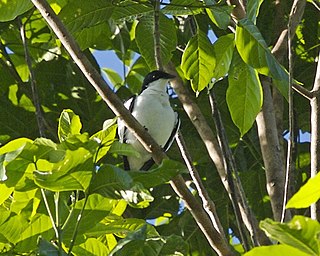
The varied triller like its better-known relative the white-winged triller, is a smaller member of the cuckoo-shrike family, Campephagidae. Varied trillers prefer warm, reasonably moist environments and are found in New Guinea and the Bismarck Archipelago, along much of the tropical and sub-tropical coastal hinterland of eastern Australia, from about the Sydney area to the tip of Cape York Peninsula, in the moister part of the Kimberley, and throughout the Top End.

The Réunion cuckooshrike is a passerine bird in the cuckooshrike family. It is endemic to the island of Réunion, where it is restricted to two areas of mountain forest in the north of the island. Males are dark grey above and pale grey beneath, while females have dark brown upper parts and a streaked breast. The population has been declining and the range contracting, being currently about 16 square kilometres (6.2 sq mi), and the International Union for Conservation of Nature has rated the species as "critically endangered", with the possibility that the bird could be wiped out by a tropical storm. Conservation efforts are being made by attempting to control the cats and rats which prey on the chicks, and this seems to have resulted in the population stabilising.

The Madagascar partridge is a species of bird in the family Phasianidae. It is widespread across Madagascar. It has been introduced to Réunion.

The silver-rumped spinetail or silver-rumped needletail is a species of swift in the family Apodidae. It is found in Brunei, Indonesia, Malaysia, Myanmar, Singapore, and Thailand. Its natural habitat is subtropical or tropical moist lowland forests.

The black-throated shrikebill or black-faced shrikebill is a songbird species in the family Monarchidae.

The Indochinese cuckooshrike is a species of bird in the family Campephagidae. It is found in Cambodia, Laos, Myanmar, Thailand, and Vietnam. Its natural habitats are subtropical or tropical moist lowland forest and subtropical or tropical moist montane forest.

The Mauritius cuckooshrike is a species of bird in the family Campephagidae. It is endemic to Mauritius.

The purplish jay is a species of bird in the family Corvidae. It is found in northern Argentina, Bolivia, southern Brazil, Paraguay and southeastern Peru. Its natural habitats are subtropical or tropical dry forest, subtropical or tropical moist lowland forest, and heavily degraded former forest.

The yellow-sided flowerpecker is a species of bird in the family Dicaeidae. It is endemic to Sulawesi and adjacent islands in Indonesia.

The black-browed triller is a species of bird in the family Campephagidae. It is found in northern New Guinea. Its natural habitats are subtropical or tropical moist lowland forests and subtropical or tropical mangrove forests. The Biak triller was formerly considered a subspecies.

The rufous-bellied triller is a species of bird in the family Campephagidae. It is endemic to North Maluku in Indonesia. Its natural habitats are subtropical or tropical moist lowland forests and subtropical or tropical mangrove forests.

The long-tailed triller is a species of bird in the family Campephagidae. It is found in New Caledonia, Solomon Islands, and Vanuatu. The Norfolk Island subspecies of the long-tailed triller, the Norfolk triller, has become extinct. Its natural habitats are subtropical or tropical moist lowland forests and subtropical or tropical moist montane forests.

The black-and-white triller is a species of bird in the family Campephagidae. It is endemic to the Philippines.

The Samoan triller, known in Samoan as miti tae, is a species of bird in the family Campephagidae. It is endemic to Samoa. Its natural habitats are subtropical or tropical moist lowland forest and plantations. It is threatened by habitat loss.

The Yap monarch, or Yap Island monarch, is a species of bird in the family Monarchidae. It is endemic to the Yap Main Islands, Micronesia. Some authorities consider the Yap monarch to belong to the genus Metabolus. Its natural habitats are subtropical or tropical moist lowland forests and subtropical or tropical mangrove forests. The natives of Yap Island call it "Gigiy" or "Achgigiy".

The buff-bellied monarch is a species of bird in the family Monarchidae. It is monotypic within the genus Neolalage. It is endemic to Vanuatu, where its natural habitat is subtropical or tropical moist lowland forests.

The São Tomé weaver is a species of bird in the family Ploceidae. It is endemic to São Tomé and Príncipe. They are found in the island of São Tomé. Its natural habitats are subtropical or tropical moist lowland forests and subtropical or tropical moist montane forests.

The São Tomé paradise flycatcher, also known as São Tomé flycatcher, is a species of bird in the family Monarchidae. The species was described by Thomas Richard Heywood Thomson in 1842, with Tchitrea atrochalybeia the binomial and Fernando Po given as the type locality. The species is endemic to São Tomé Island. Its natural habitats are subtropical or tropical dry forests and subtropical or tropical moist lowland forests.

Lalage is a genus of passerine birds belonging to the cuckooshrike family Campephagidae, many of which are commonly known as trillers. There are about 18 species which occur in southern Asia and Australasia with a number of species on Pacific islands. They feed mainly on insects and fruit. They build a neat cup-shaped nest high in a tree.
The Biak triller is a species of bird in the family Campephagidae. It is found on Biak. Its natural habitats are subtropical or tropical moist lowland forests and subtropical or tropical mangrove forests. It was formerly considered a subspecies of the black-browed triller, but was split as a distinct species by the IOC in 2021.



















